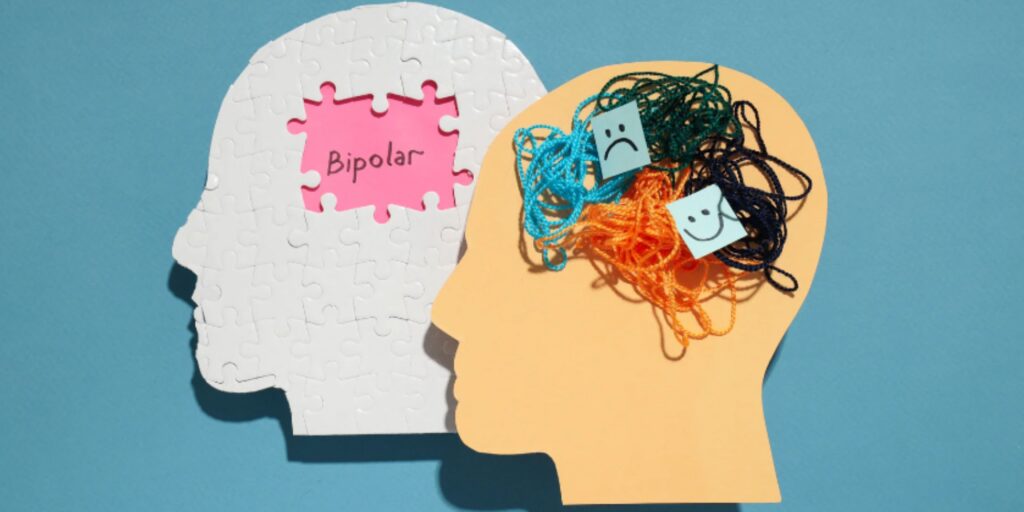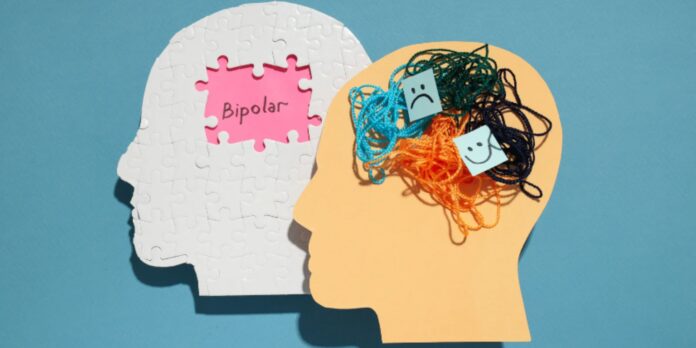There is a lot more to bipolar disorder than mood changes. It’s a complicated mental health condition that takes an in-depth understanding to treat properly. This guide tries to offer a thorough understanding of bipolar disorder symptoms and treatments, whether you’re a person with the sickness, a loved one, or just interested in finding out more.
Table of Contents
What is Bipolar Disorder?
Bipolar disorder, previously referred to as manic-depressive illness, is a mental condition marked by extreme emotional changes, including sadness and manic or hypomanic highs. These episodes can all impact sleep, energy, activity, judgment, behavior, and clear thinking. There are various forms of bipolar disorder, and the pattern and severity of symptoms distinguish each.

Types of Bipolar Disorder
Bipolar I Disorder: Manic episodes lasting at least seven days or manic symptoms severe enough to require emergency hospitalization are indicative of bipolar I disorder. There are also depressive periods, which usually continue for two weeks or longer.
Bipolar II Disorder: The main feature of bipolar II disorder is a series of hypomanic and depressed episodes rather than the full-blown manic episodes that characterize bipolar I disorder.
Cyclothymic Disorder: The requirements for diagnosis for a hypomanic episode and a depressive episode are not fulfilled by the symptoms of cyclothymic disorder, which is characterized by periods of hypomanic symptoms and depression episodes that endure for at least two years (one year in children and teens).
Symptoms of Bipolar Disorder
It is important to understand the symptoms in order to identify and manage patients early. Manic, depressive, and mixed episodes are the three primary categories of bipolar disorder symptoms.
Manic Episodes
High or irritated mood, hyperactivity, fast speech, inflated self-esteem, and a decreased need for sleep are all characteristics of manic episodes. Amongst the symptoms are:
- Increased energy, activity, and restlessness
- Excessively high or euphoric mood
- Extreme irritability
- Racing thoughts and talking very fast
- Distractibility
- Decreased need for sleep
- Unrealistic beliefs in one’s abilities and powers
- Poor judgment and risky behaviors
Depressive Episodes
Extreme sadness, despair, and a loss of interest in once-enjoyed activities are all possible outcomes of depressive episodes. Amongst the symptoms are:
- Prolonged sadness or empty mood
- Feelings of hopelessness or pessimism
- Feelings of guilt, worthlessness, or helplessness
- Decreased energy and fatigue
- Difficulty concentrating, remembering, and making decisions
- Restlessness or irritability
- Sleep disturbances
- Appetite and weight changes
- Thoughts of death or suicide
Mixed Episodes
Mania and depression symptoms combine in mixed periods. This might result in feelings of hopelessness, despondency, and an inability to enjoy activities, along with excessive energy, bad judgment, and intense irritation.
Causes and Risk Factors
While the exact cause of bipolar disorder is in doubt, a number of factors may be involved.
Genetic Factors
The propensity for bipolar disorder to be present in families suggests that it has a genetic component. Multiple genes may be implicated, according to research, and having a family history of bipolar disorder increases the risk.
Environmental Factors
Significant life upheavals, trauma, and stress may cause or worsen bipolar episodes. The start and progression of the condition are influenced by the interaction between genetic predispositions and these external factors.
Brain Structure and Function
Differences in the structure and function of the brain could potentially contribute to bipolar illness. Studies using neuroimaging have revealed anomalies in the prefrontal cortex and other mood-regulating brain areas.
Diagnosis of Bipolar Disorder
A mental health expert must conduct a complete evaluation in order to diagnose bipolar disorder.
Criteria for Diagnosis
Specific criteria, such as the duration and extent of mood episodes, are outlined in the Diagnostic and Statistical Manual of Mental Disorders (DSM-5) for the diagnosis of bipolar disorder.
Diagnostic Tools and Assessments
Important steps in the diagnosis procedure include family history, mood charts, and psychiatric tests. To rule out other conditions, physical exams and laboratory testing may be conducted occasionally.
Bipolar I vs. Bipolar II
Given the fact that both kinds involve mood swings, there are important differences.
Key Differences
Bipolar I Disorder: Manic episodes in bipolar I disorder are more powerful and could result in psychosis.
Bipolar II Disorder: Less severe hypomanic episodes and protracted depressive episodes are characteristics of bipolar II disorder.
Symptoms Comparison
Bipolar II is characterized by more major depressive episodes with hypomania, while Bipolar I is usually characterized by more severe manic episodes.
Living with Bipolar Disorder
Bipolar disorder presents special challenges, but with the right care and support, many people with the disease enjoy happy, fulfilled lives.
Personal Experiences
Getting insight and hope from others who manage bipolar disorder can be very beneficial. Their experiences frequently demonstrate the value of strong support networks and efficient treatment programs.
Impact on Daily Life
Bipolar disorder has an impact on relationships, jobs, and day-to-day activities. Understanding these effects facilitates the creation of adjustments and ways to cope.
Treatment Options
Controlling symptoms, reducing the frequency and extent of episodes, and improving overall functioning are the objectives of treatment.
Medication
Medication is often the cornerstone of treatment.
Mood stabilizers: such as lithium.
Antipsychotics: Such as quetiapine.
Antidepressants: Often used cautiously and in combination with mood stabilizers.
Therapy
Therapy helps in a person’s understanding and management of their medical condition.
Cognitive-Behavioral Therapy (CBT): The goal of cognitive-behavioral therapy, or CBT, is to alter unfavorable thought patterns.
Interpersonal and Social Rhythm Therapy (IPSRT): improves interpersonal interactions and helps to normalize daily routines.
Lifestyle Changes
Changing one’s lifestyle is a must for controlling bipolar disorder.
Exercise and Diet: Eating a balanced diet and doing regular exercise help with mood and general health.
Sleep hygiene: It’s very important to keep a regular sleep routine.

Managing Bipolar Disorder
Effective management involves a combination of treatments and support systems.
Coping Strategies
Creating individualized coping mechanisms, such stress reduction methods, is important for stability.
Support Systems
It is crucial to have the support of friends, family, and support groups.
Function of Friends and Family: Compassionate and encouraging connections aid in symptom management.
Support groups: Offer a feeling of camaraderie and agreement.
Challenges in Treatment
Despite current therapies, bipolar disorder can be difficult to manage.
Medication Adherence
It can be challenging to take medication as directed because of side effects or a desire to leave during times of stability.
Side Effects of Treatment
Medication side effects can include tremors, weight gain, and gastrointestinal problems. To properly manage them, communication with healthcare providers is important.
The Role of Healthcare Providers
A team of healthcare providers typically manages bipolar disorder.
Psychiatrist
Specializes in diagnosing and treating mental health conditions and can prescribe medication.
Psychologist
Provides therapy and helps develop coping strategies.
General Practitioners
Offer ongoing medical care and monitor overall health.
Preventing Relapse
Preventing relapse involves recognizing early warning signs and adhering to a treatment plan.
Early Warning Signs
Identifying changes in mood, sleep, and behavior can help prevent full-blown episodes.
Maintenance Treatment
Continuous treatment, even during stable periods, is crucial for long-term stability.
Myths and Misconceptions
There are many myths about bipolar disorder that can lead to stigma and misunderstanding.
Common Myths
- Bipolar disorder is just mood swings.
- People with bipolar disorder can’t lead normal lives.
The Reality
Although bipolar disorder is a serious condition that has to be treated, people with it can lead fulfilling lives if they manage it well.
Current Research and Future Directions
Research is ongoing to improve understanding and treatment of bipolar disorder.
Ongoing Studies
Studies focus on genetic factors, brain imaging, and new treatment options.
Promising Treatments on the Horizon
Emerging treatments include new medications and innovative therapy approaches.
Conclusion
For bipolar disorder to be properly controlled and supported, understanding is important. People with bipolar disorder can enjoy happy, fulfilling lives if they receive the right care. Research is still ongoing to help us better understand and manage this complicated disorder.
FAQs
What are the main types of bipolar disorder?
The main types are bipolar I disorder, bipolar II disorder, and cyclotomic disorder.
How is bipolar disorder diagnosed?
Diagnosis involves a thorough psychiatric evaluation, mood charting, and family history. Sometimes, physical exams and lab tests are used to rule out other conditions.
Can lifestyle changes help manage bipolar disorder?
Yes, lifestyle changes such as a balanced diet, regular exercise, and good sleep hygiene can significantly help manage symptoms.
What should I do if a loved one has bipolar disorder?
Offer support, encourage treatment adherence, and educate yourself about the disorder to provide better support.
Are there any new treatments for bipolar disorder?
Ongoing research is exploring new medications and therapies that show promise for better managing bipolar disorder.

